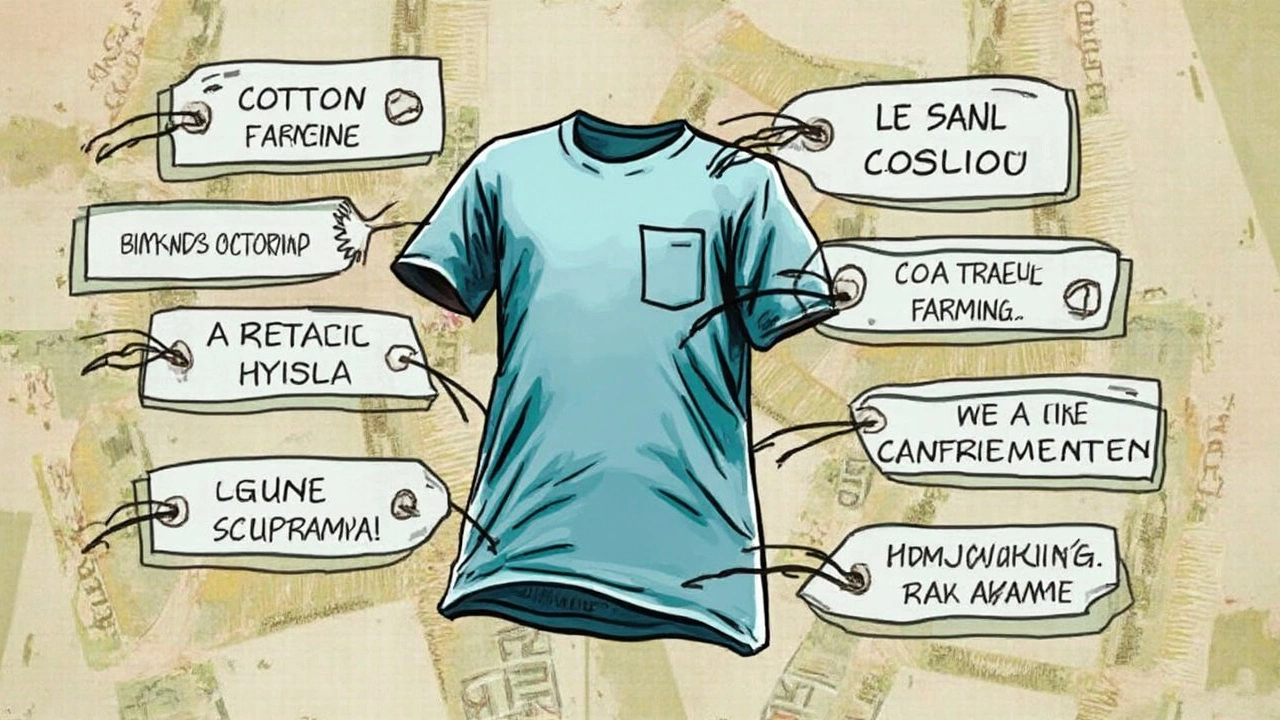You walk into a store, grab a plain tee, flip the tag—and bam, it's thirty bucks for something that used to cost ten. The spike in t-shirt prices isn’t just because brands want to cash in. It’s a whole chain of real costs that starts way back with cotton plants and ends with shipping, taxes, and clever branding tricks.
If you’re tired of sticker shock in the T-shirt aisle, it helps to know where your money goes. Cotton prices don’t just rise on their own—bad harvests, heat waves, and global demand shake things up. Sourcing eco-friendly or organic cotton? That bumps the price more, and not by a little.
Then there’s the people side. Factories with fair pay and safe conditions obviously cost more. As brands try to do better, every extra dollar for a worker comes out in the price tag. And let’s not ignore the marketing machine—your basic tee pays for influencer deals, glossy ads, and fancy packaging, not just the fabric.
- Raw Materials and Fabric Costs
- Labor, Production, and Ethical Practices
- Brand Markups and Marketing Hype
- Smart Ways to Save on T-Shirts
Raw Materials and Fabric Costs
Let’s talk basics. Making t-shirts starts with raw materials—usually cotton. But not all cotton is the same. The regular stuff is cheaper, but more and more brands now use organic cotton or recycled fibres. These options are healthier for the planet, but farmers grow less of them, and harvesting is trickier. That pushes up the price before you even get thread.
Here’s something wild: in 2024, cotton prices shot up by about 15%. Why? Droughts in key growing regions like India and massive demand from countries like China. When weather messes up a big crop, the price hikes hit everywhere, right down to the shirt you buy at the mall.
T-shirt prices also rise with the type of fabric. A soft, lightweight tee tends to use combed or ring-spun cotton—way pricier than standard blends. Look at shirts labeled "Supima" or "Pima" cotton. That’s luxury stuff, and the premium isn’t just hype. It’s grown in just a few places, has longer fibres, and feels smoother.
It’s not just about the cotton. Want a T-shirt that stretches? Add some spandex or modal, and the price climbs. Special dyes, treatments for shrink-resistance, or eco-friendly processes also ramp up the cost.
| Fabric Type | Avg. Cost Per Pound ($) |
|---|---|
| Regular Cotton | 0.70 - 0.90 |
| Organic Cotton | 1.10 - 1.50 |
| Pima/Supima Cotton | 1.50 - 2.20 |
| Blends (w/ Modal, Spandex) | 1.30 - 2.00 |
If you're wondering why a basic tee at a fast-fashion shop is $8, while a similar one elsewhere can be $30 or more, remember: what goes into the t-shirt—from the type of cotton to specialty fabric blends—drives a lot of the real cost.
Labor, Production, and Ethical Practices
This is where most of your T-shirt’s price adds up, and a lot of shoppers don’t realize it. Making a t-shirt isn’t just about the material; it’s about the people who actually sew, dye, and pack it up. The truth is, the cheapest shirts come from factories that pay bare-minimum wages, sometimes just a few dollars a day. And that’s not just overseas—many factories worldwide cut corners this way because it keeps prices low for brands, not workers.
Lately, there’s more pressure on brands to ditch sweatshops and look after workers. Everyone’s heard horror stories of dangerous factories, or brands linked to child labor scandals. Now, more companies are highlighting their "ethical" shirts made in WRAP-certified factories or Fair Trade-approved shops. But none of this comes for free. Paying a living wage, offering safe workspaces, giving regular hours—all this easily doubles or even triples production costs per shirt. That’s before you add costs for things like modern dyeing processes that use less water or recycle chemicals.
Check out how much labor impacts t-shirt costs:
| Production Type | Worker Pay (per shirt) | Avg. Retail Price |
|---|---|---|
| Standard Fast Fashion | $0.10 | $10–$18 |
| Ethical & Fair Trade | $1.00–$3.00 | $25–$40 |
Making the switch to ethical production creates a chain reaction. Higher wages and safer workspaces also mean factories aren’t cutting corners. It usually results in better quality shirts, too—no loose seams or twisted fits after one wash.
If you wonder what you’re actually paying for, it helps to look for certifications. Terms like WRAP, OEKO-TEX, or Fair Trade aren’t just buzzwords. They signal real investment in worker’s rights, safe dyeing, and less waste. Don’t just read it on a website, either; legit brands will show factory photos and share how they oversee their supply chain. That transparency is worth paying a little extra for—especially if you care about what your t-shirt really costs in the real world.

Brand Markups and Marketing Hype
Ever notice how two basic t-shirts that look almost identical can have totally different price tags? That’s brand markup in action. A plain tee from a name brand can easily cost two or three times more than one from a generic label. A big chunk of the price you pay goes straight into the brand’s pocket, not just into better fabric or design.
Here’s what a lot of folks don’t see: brands spend big on ads, influencers, and that feeling of exclusivity. When a celebrity wears a certain t-shirt, demand jumps up, and so does the price. Companies also run limited editions or talk up their sustainability just to keep the hype (and the price) high.
Check out this breakdown from a 2023 Business of Fashion report. On average, the retail price of a branded tee is marked up by 60-80% over the cost to make it. No joke—a shirt that costs $7 to produce often sells for $30 or more.
| Production Cost | Wholesale Price | Retail Price |
|---|---|---|
| $7 | $14 | $30 |
And that doesn’t even cover the cost of all the logo stickers and shopping bags. You’re also paying for stuff like slick website design, glitzy store interiors, and those constant Instagram ads in your feed.
Brands know how to tap into emotions. We hear, "you’re not buying a t-shirt, you’re buying a lifestyle." As fashion editor Vanessa Friedman once said,
“When it comes to basic clothing, people are not necessarily paying for the garment itself, but for what it represents.”
If you want to avoid the trap, skip the heavy branding. Check the tag for the real materials, and see what the brand’s actually offering. Sometimes generic is just as good—and way lighter on the wallet.
Smart Ways to Save on T-Shirts
You don’t have to get ripped off every time you buy t-shirts. Getting a good deal just takes a little smart shopping—and knowing the tricks brands use doesn’t hurt either. Let’s break down some simple moves to keep your closet fresh and your wallet happy.
- Buy in Multi-Packs: A single tee can cost a heap, but packs of three or five slash the price per shirt. Big stores like Uniqlo or Target often sell basics in value packs, knocking the price down by up to 30% compared to singles.
- Follow Brands for Discounts: Most clothing companies run regular sales and loyalty programs. Signing up for a newsletter or following them on socials often lands you 10-20% off on your first order or during seasonal sales events.
- Check Out Outlet Stores: Many major brands push last season’s t-shirt stock to outlets. These can be the exact same shirts you see at full-price retailers, just way cheaper after a season passes.
- Shop Off-Season: Buying short sleeves in the winter or long sleeves in the summer feels weird, but it means grabbing deals. Clearance racks tend to be full of out-of-season clothes for way less.
- Go Thrift or Secondhand: Apps like Depop, Poshmark, or even local thrift shops can net high-quality or even vintage tees for a fraction of retail cost. You’re not just saving cash—you’re also keeping another shirt out of a landfill.
Here’s a look at how much you could actually save if you shop using some of these strategies:
| Buying Method | Average Price Per Shirt (USD) |
|---|---|
| Single Retail Shirt | $25 |
| Multi-Pack (3-5) | $12-15 |
| Outlet Store | $8-15 |
| Thrift/Secondhand | $2-10 |
Another tip: Skip the super fancy logo tees unless you really want them. Many of those higher-priced shirts use the same base fabric as cheaper ones, but slap a brand name on top. Always check the tag for fabric content—100% cotton or a cotton blend with a bit of stretch lasts longer and feels better. The simple version? Don’t let hype or a slick hangtag drain your cash when you’re buying t-shirts.
